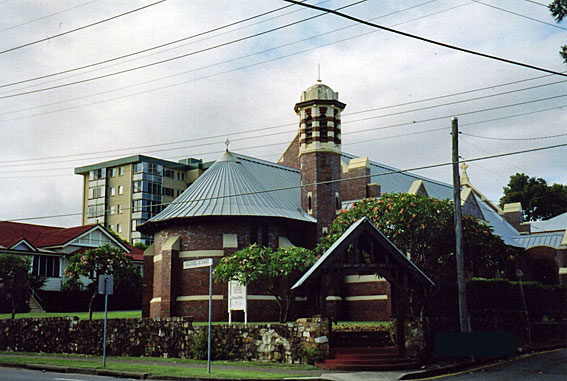
St Paul's Anglican Church, East Brisbane
[Photograph by Geoffrey Cox (January 2006)]

St Paul's Anglican Church, East Brisbane
[Photograph by Geoffrey Cox (January 2006)]
Historical and Technical Documentation by Geoffrey Cox
© OHTA 2011, 2013, 2017, 2022 (last updated Jauary 2022)
The Anglican Parish of St Paul's, East Brisbane dates from 1887. The present church was opened and dedicated on Sunday 21 September 1924, having been built to the design of the Brisbane architects, Atkinson & Conrad.1 The same architects were responsible at this time for the design of buildings nearby at the Anglican Church Grammar School, where the use of the interwar Old English style can also be observed.
First Organ.
The original organ in this church came from Holy Trinity Anglican Church, Fortitude Valley, where it had been installed in 1874.2 It was moved twice at Fortitude Valley, and was installed at East Brisbane by Whitehouse Bros in 1924, the year in which the present church was opened. Whitehouse Bros supplied an electric rotary blower and a 'new pedal board' at the same time.3 The organ occupied the small organ chamber on the right-hand side of the chancel.
The details of the instrument can only be reconstructed with difficulty: John Davidson, who was organist of this church in the early 1950s, recalled clearly that the builder's nameplate included the address 'Gray's Inn Road, London' and the date 1850.4 The date was also recorded as 1850 and the builder's name as 'Russell of London' by Bernie Brohan,5 and it can thus be concluded with reasonable certainty that the builder was Timothy Russell, who reportedly set up his organ-building establishment at 2 Gray's Inn Terrace, London in 1828. His last known organ was built in 1858.6
It is curious that a newspaper account of February 1874, when the organ was opened at Holy Trinity Anglican Church, Fortitude Valley, states that it was purchased from 'W. Hill and Son.'7 There is no record of Hill & Son supplying an organ for the Fortitude Valley church, although it is possible they may have supplied a second-hand one. The same newspaper account describes the organ as having eleven draw stops, which agrees with the details of the organ given below, as recorded at East Brisbane.8
According to the surviving accounts, the organ consisted of a single manual and pedals, with completely unenclosed pipework. The specification can be reconstructed with reasonable accuracy from several independent sources:
| MANUAL (unenclosed) Open Diapason Stopped Diapason (Treble) Stopped Diapason (Bass) Dulciana Principal Flute Twelfth Fifteenth Mixture PEDAL Bourdon COUPLER Manual to Pedal |
8 8 8 8 4 4 2-2/3 2 II 16 |
[Ten. C] [Ten. C] [Ten. C] |
Mechanical action
Pedalboard: radiating & concave [1924]
Compass: not recorded
3 combination pedals.9
The organ was rebuilt in 1953-54 by John Hamer-Howorth, who was a student at St Francis' Theological College in Brisbane at the time. Hamer-Howorth placed the Open Diapason (the lowest five notes of which were stopped wood) on a new pressure-pneumatic chest, with octave coupler. He enclosed the remainder in a swell box with vertical shutters, and provided a secondhand Oboe (Tenor C) in place of the Open Diapason on the old soundboard, which retained tracker action.10 The instrument was broken up and removed around 1955 or 1956 by H.W. Jarrott of Brisbane and Walter Emerson of Toowoomba. The Dulciana 8ft, Principal 4ft and Oboe 8ft stops were incorporated by Walter Emerson into the organ at St Paul's Anglican Church, Stanthorpe.11 Hamer-Howorth's façade, which included 25 metal Open Diapason pipes, remained at East Brisbane until at least the mid 1970s, and there are reportedly still some remnants of an organ façade stored elsewhere at the church.12 The organ chamber has since been converted into a chapel.13
Second Organ.
The second organ was built in November 1952 by Whitehouse Bros of Brisbane for the Baptist Church, Wynnum, at a cost of £1036,10.0.14 It was dedicated at the Wynnum church by the Rev. A.J.N. Howard on 12 November.15 This instrument comes from the final years of the firm's pneumatic-action instruments, and the tonal design is dominated by string stops, lacking either a manual Gedact stop or a pedal Bourdon.
Three of the four manual ranks are enclosed, while the Gamba 8ft stop is located outside the box. There is no casework, and the pedal string rank forms the façade on either side of the console. The central façade pipes are non-speaking. The stop-keys were the standard triangular-block type, placed above the manual.
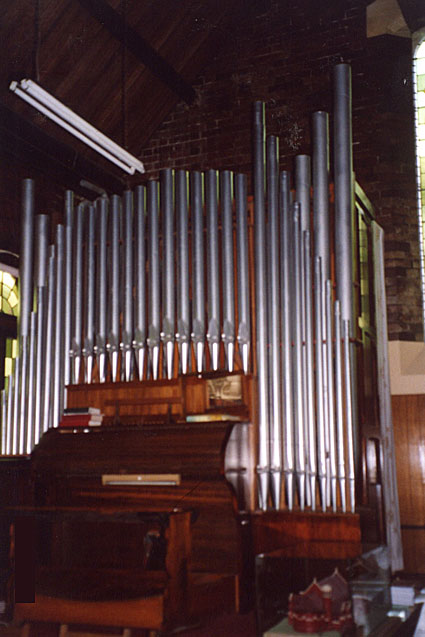
The 1952 Whitehouse organ
[Photograph by Geoffrey Cox (February 2007)]
At Wynnum, the organ was removed in 1975 to a new building on the same site by H.W. Jarrott, who made some minor modifications to the arrangement of the façade pipes.16 It was installed in its present location in 1993 by W.J. Simon Pierce.17 In late 2017, Ian D. Brown and Associates of Ballina releathered the single-rise bellows and adjusted the winding to stabilise the tuning.18
At East Brisbane, the organ was located on a raised platform in one corner at the rear of the church, the former organ chamber having been coverted into a chapel.
| MANUAL Open Diapason Gamba Dulciana Flute PEDAL Cello COUPLERS Great to Pedal Swell Octave |
8 8 8 4 16 |
(enclosed, except for Gamba 8ft) [stpd bass] [gvd bass] [sic] [sic] |
Tremulant
Pneumatic action.
Balanced swell pedal
Attached stop-key roll-top console
Compass: 61/30.19
Third Organ.
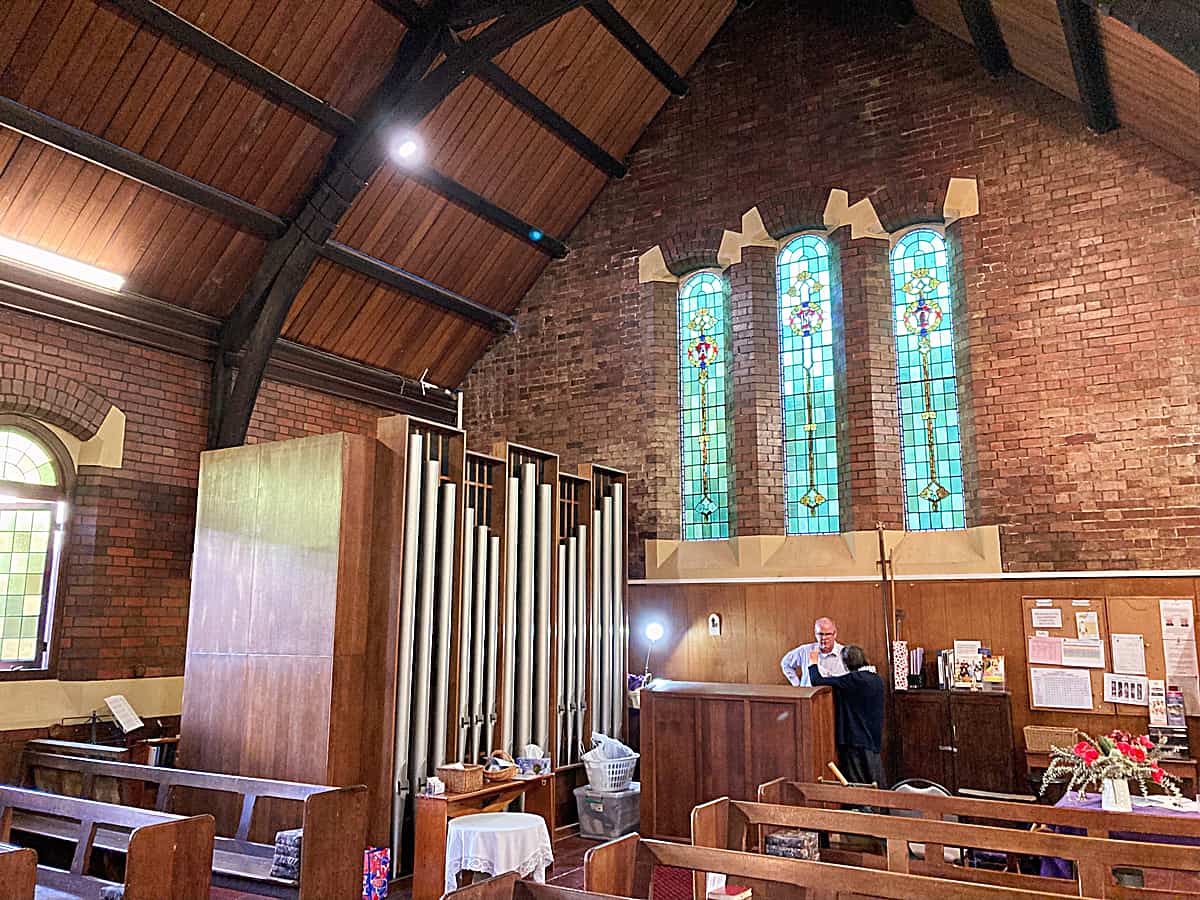
The organ and console from the nave in St Paul's Anglican Church, East Brisbane
Photograph by Christopher Trikilis (September 2023)
Jewkes removed the instrument to storage in 2013, and it is to be installed in 2022 at East Brisbane by Ian D. Brown and Associates of Ballina. It will occupy the same position (at the back of the church) as was occupied by the Second Organ.21
The stop list remains unchanged from that recorded at Reid in 2013:
| GREAT Contra Salicional Open Diapason Rohr flute Salicional Principal Stopped Flute Salicet Twelfth Fifteenth Mixture SWELL Open Diapason Rohr Flute Salicional Stopped Flute Salicet Nazard Flautino Mixture Trompette PEDAL Bourdon Quint Flute Salicet Octave Flute COUPLERS Swell to Pedal Great to Pedal Swell to Great Double touch canceller Gt & Ped combs. coupled |
16 8 8 8 4 4 4 2-2/3 2 III 8 8 8 4 4 2-2/3 2 III 8 16 10-2/3 8 8 4 |
'prepared for' and added by Peter Jewkes in 1977 |
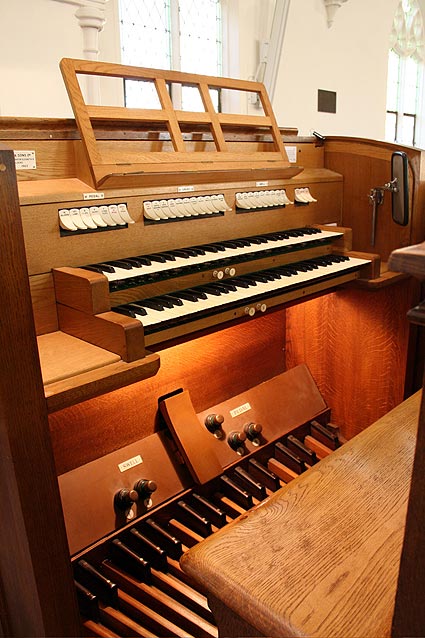
The Walker console at Reid
[Photograph by Trevor Bunning (April 2006)]
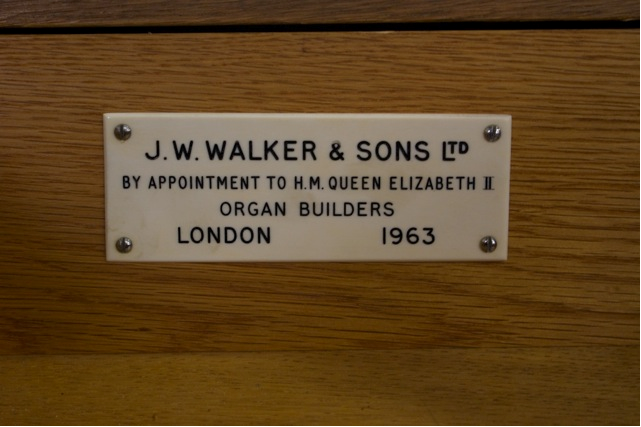
The builder’s nameplate
[Photograph by Peter Jewkes (August 2013)]
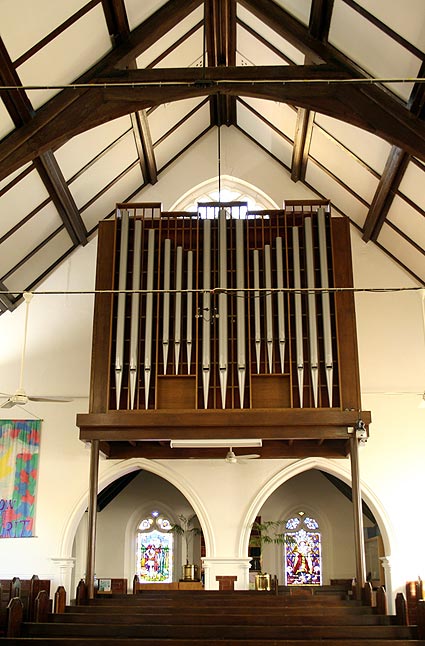
Façade of the organ at Reid
[Photograph by Peter Jewkes (August 2013)]
__________________________________________________________________
1 Anglican Diocese of Brisbane, Records & Archive Centre Guide to Records; Church Chronicle (1 September 1924), p. 174; Church Chronicle (1 October 1924), p. 200.
2 The Brisbane Courier (14 February, 1874), p. 4; 'Diary of Events' for 15 February 1874, in Pugh's Queensland Almanac, for 1875. Original location confirmed by Mr J.H. Whitehouse, 1973.
3 Whitehouse Bros Ledger (1922-1940), p. 79; Minutes of Parochial Council Meeting, Holy Trinity Church, Fortitude Valley (5 March 1924), cited by Charles Clark (organist), c.1973.
4 Letters to G. Cox from John Davidson, Canberra (18 July & 3 September 1974).
5 Collected Specifications of Bernie Brohan (c.1952).
6 Letter to G. Cox from Rev. B.B. Edmonds, U.K. (16 September 1974).
7 The Brisbane Courier (17 February, 1874), p. 2.
8 See: Holy Trinity Anglican Church, Fortitude Valley
9 Collected Organ Specifications of Bernie Brohan (c.1952), and Notebooks of Mr E.R. Salisbury. The Tenor C compass of the Dulciana 8ft and Flute 4ft is given only by E.R. Salisbury, who also queried the number of ranks in the Mixture. That the Mixture contained 2 ranks was confirmed by Dr. Reg Magee, H.W.Jarrott and Les Langham, c.1974.
10 Letters to G. Cox from John Hamer-Howorth (December 1972, January & February 1973).
11 Personal communication to G. Cox from H.W. Jarrott (January 1973) and Walter Emerson (February 1974).
12 Personal communication to G. Cox from Simon Pierce, July 2011.
13 Noted February 1974 and August 2001 by G. Cox.
14 Whitehouse Bros Ledger (1940-1954), p. 495.
15 The Courier-Mail (13 November 1952), p. 6.
16 Personal communication to G. Cox from H.W. Jarrott, 1975.
17 Personal communication to G. Cox from Simon Pierce, 2001.
18 Ian D. Brown & Associates Newsletter (December 2017), p. 2.
19 Specification noted by G. Cox, August 2001.
20 John Maidment, Gazetteer of New South Wales Pipe Organs (Melbourne: Society of Organists (Victoria), 1981), p. 62.
21 Personal communication to Geoffrey Cox from Ian Brown, January 2022.